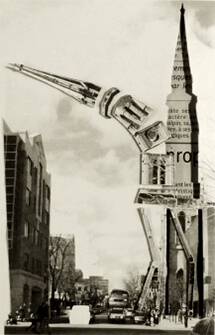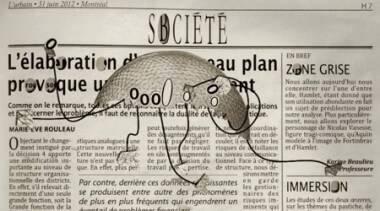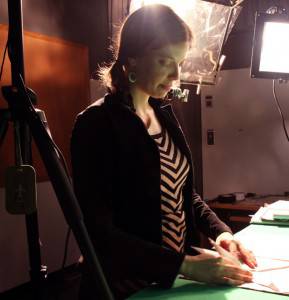Q&A with Emmanuelle Loslier
A promising recent addition to Quebec’s animation community, Emmanuelle Loslier first ventured into the visual arts while studying at Concordia University. Expanding on her body of work as both a traditional painter and digital illustrator she began working on animated student shorts in the lead-up to her involvement with the National Film Board of Canada‘s Cinéaste Recherché(e) scheme. There she developed, animated and directed her first professional short Rue de l’Inspecteur (Inspector Street), a tremendously effective and amusingly surreal piece where Montreal’s architecture develops a life of its own between the pages of a discarded newspaper. Combing digital, cut-out and origami animation, the film alternately evokes the work of Svankmajer, Borowczyk, Gilliam and even PES. During a recent visit to the NFB, Skwigly managed to get some time with Emmanuelle and learn more about this intriguing first film’s backstory.
Can you describe the process of getting this film picked up by the NFB initially?
Well, it was a contest at first – Cinéaste Recherché(e) – which gives young filmmakers who have never produced a professional film the chance to do so. So I submitted my project. After the projects are accepted there is a long pre-production process where you usually work out your scenario with someone experienced, so I was with another director who looked at my scenario; We’d work together and he’d tell me which parts should be shorter or different.
Sort of helped to fine-tune the concept?

“Rue de l’Inspecteur” (Emmanuelle Loslier/NFB)
Exactly. So afterward I worked with Nicolas Brault, a director in the animation team, and we developed the technical aspect more. I had the idea of what I was going to do with the film, I wanted to use a certain technique but didn’t know how I was going to get there, so we developed the technique and he explained to me how to work with the green screen. So it was a long pre-production, it took us about six months of doing tests and reworking the scenario. Also, because the film occurs inside a newspaper I wanted to make my own, so I spent a lot of time creating it.
So the newspaper in the film is entirely made from scratch?
Home-made, yeah, exactly. I’d ask my friends to give me some text because I needed words to fill the paper!
It feels like the process is more analogue than digital, was it all cut-out and reassembled by hand?
It’s really a mix of both. I did a long shoot under the camera in a studio, so all the cut-out animation parts are real stop-motion, paper animation. But we have almost half of the film done with compositing, not just post-production because we did some animation also, during the compositing. We also had live-action exteriors with actors, we had to take pictures and match the background to the green-screen animation. All of which was done in After Effects, as well as the animation of the 2D ink lines.
So was there anything in particular that got you onto the main visual theme, the architecture and newspaper elements coming to life and interacting with each other?
Well, I really like to integrate the animation world into the real world, as they’re such completely different universes. One day I was outside and I was looking at this big church, I thought it looked like a bird and that maybe I could do something with that. I love architecture too, and I love to see characters in the objects, houses, churches. So I took a lot of pictures of the city and I tried to find characters in them. The first thing I had were the pictures of the characters in the newspaper, it’s really based on these four pictures that become four characters. I knew it would be in a newspaper but I didn’t know where we would go to shoot, because I wanted a real person to put down this newspaper, leave and come back so they could interact with this kind of character the newspaper itself has become. But I didn’t know where to go that looked like a downtown area but not so busy, so I went with Nicolas to a lot of places in the city to find the right one. After about three hours we found this nice building that was kind of old and it was on the street named Rue de l’Inspecteur, which is what inspired the title and adding the character of the Inspector. I thought it could be a good title because it’s mysterious and a bit film noir.
Roughly how long did it take to get the whole film produced?
Everything including pre-and-post-production took a year and a half, so it was quite fast for an animated film. The production itself was ten months, so it was almost as long to do the rest.
How involved were you for the filming of the live-action sequences?
I was involved but I had a separate crew. It was just one day of shooting with a little team of five of us, it was really interesting. We spent the day there from early morning to sunset, it was a really great experience, totally different from animation, working outside with a group.

“Rue de l’Inspecteur” (Emmanuelle Loslier/NFB)
Have you found that the NFB has been a good environment for beginning filmmaking and nurturing your interests?
It really has, I’ve had the chance to work with professional people and it’s really well-structured. My producer Julie Roy gave me a lot of space but I could always feel she was there to help me when I was not sure about things. When you work with professional filmmakers and editors it’s really good to have a professional producer who will help you to do something bigger than you could do on your own. I always felt like people left me space, I never felt that anyone wanted to impose on my idea. It was a great experience, kind of hard because when you’re here you see these filmmakers and movies and prizes, and when I came here it was a lot of productions wrapping up, so each week we saw playbacks of new movies where it was like “Oof! I’m not sure I can do something this big, y’know?’ But I’m pretty happy with the final result.
And it’s been performing well?
Yeah, I recently came back from the mountains at FICFA (Festival international du cinéma francophone en Acadie). So I’ve been able to travel a bit with my film and it’s really great. I had the premiere here in Montreal and for now it’s playing a little bit in Canada, but I hope it’s gonna travel a little bit around the world.
What are you working on at the moment?
I’m working on the colours for a project with another filmmaker at the NFB. It’s almost at the end so afterwards I think I’m gonna dive into another project that’s in my head, I need to spend a little time creating a little bit. I needed to take a break after Rue de l’Inspecteur – it was a big thing, but now after six months I think I’m ready to move on to something else.
To find out more about Rue de l’Inspecteur and Emmanuelle Loslier you can visit the film’s NFB page and emmanuelleloslier.com



